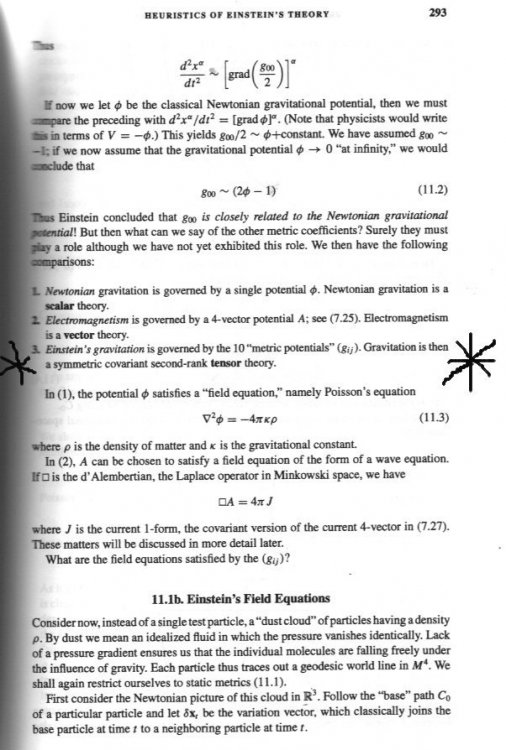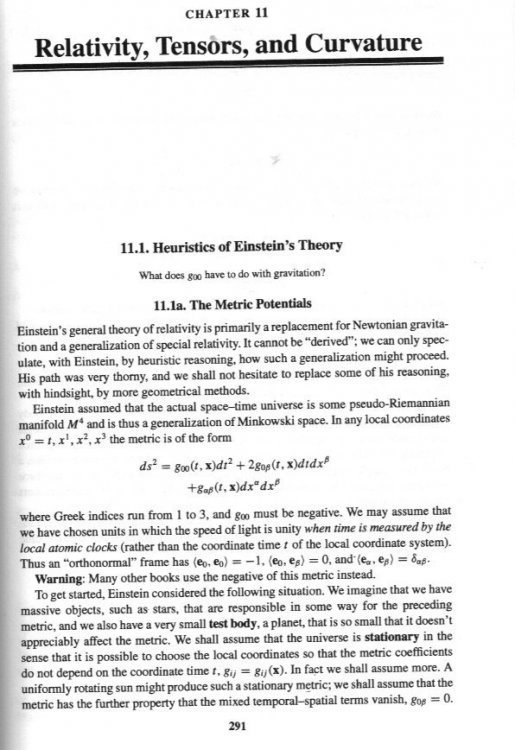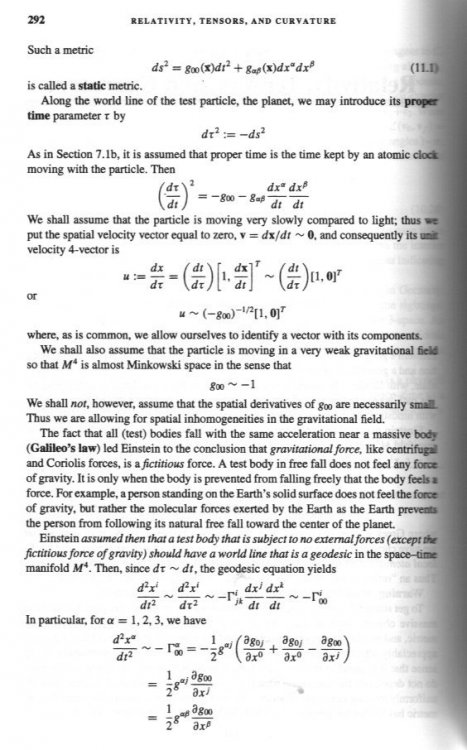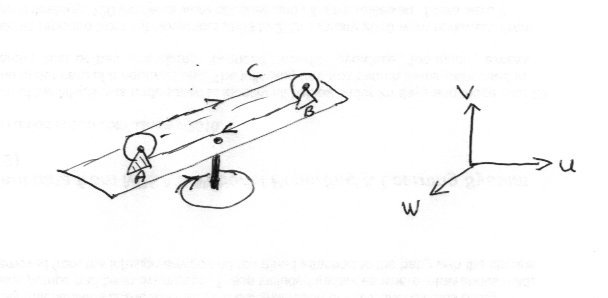-
Posts
18315 -
Joined
-
Last visited
-
Days Won
104
Content Type
Profiles
Forums
Events
Everything posted by studiot
-
To understand electron affinity properly you need to understand three terms. Electron affinity Electronegativity Ionisation energy Before I reply about electon affinity how about you put some more meat on the bones of your question to connect it to your opening post?
-

layer logic - alternative for humans and aliens?
studiot replied to Trestone's topic in Speculations
Thank you for this and your previous reply. However I was really looking for specifics wbout your system we could discuss but you made no refernce to it. As to my chinese problem, I was suggesting running the solution in your layer logic scenario and what I understand by layers for comparison purposes. But you have not doen this you you now assert that your method cannot solve those three simultaneous equations? Note the chinese wrapped the problem up in many words; I have just posted the core math of it in modern algebra. -
Thank you Marcus for opening yourself up and producing your best post ever. +1 It contains so many well put points I have just picked one out to create a forum quote.
-

Ethanol Evaporation When in Large Quantities
studiot replied to 0ut0ft0uch's topic in Organic Chemistry
I just have this vision of a poor little groundsman staggering along with a thousand gallon tank of ethanol on his back. I don't know what this is for but surely anyone seriously contemplating this course of action should consider the practicalities of it. First off : What are you trying to achieve cleaning or decontamination? When you solvent clean something you don't just apply solvent and let it evaporate - that won't clean anything. You need to physically remove the solution of solvent and dirt. There used to be an advert : Wipe it on, wipe it clean with Windolene, which was a methanol formulation. In your case I would expect spraying with an ethanol preparation to be followed by (power) washing down. Your problem is less likely to be aerial than contamination going down the drains. -
Leading up to Marcus' comment I have marked the relevant result on the third page. @rjbeery I don't know how deeply you want to go but this is a simple derivation with one static source of gravitational potential. Your theory must predict/reproduce what happens with multiple sources. I don't know if anyone has considered time dilation at lagrange points and lines where there are at least two such potentials.
-
Good question. I wanted to avoid doing that at this stage because officially (mathematically) the more negative something gets the smaller it is in that -2 is less than -1 Notice that Marcus carefully ued the absolute value or modulus symbol and also talked about making the vector longer (not larger), perhaps to avoid discussing making the vector shorter. We do not know the mathematical ability of XVV, for instance whether he knows about the sine function or vectors so I was trying to keep it simple. But also consider this. A sine wave has symmetrical positive and negative parts. But if we multiply the wave by 2, thereby doubling its size, do you consider the negative parts made smaller or larger?
-

layer logic - alternative for humans and aliens?
studiot replied to Trestone's topic in Speculations
I'm not sure it's 'layer' relevant but it's a good point. +1 -
Captain Panic would be your man for European Chem Eng topics. or more widely OldChemE, from the New World.
-

layer logic - alternative for humans and aliens?
studiot replied to Trestone's topic in Speculations
Thank you for your replies. Unfortunately although they have shed some light, they leave me more puzzled than ever. Both the quoted examples assert ( in different ways) the independence of one 'layer' from another. So how is it possible to establish the 'truth value' of any succeeding or preceeding layer, given the truth value in a particular layer. This must be so since with your simple example of the truth value of any layer immediately succeeding the given one must be opposite to the given value. So there must be more to it than this Since you like quoting Chinese philosophers, here is a problem that is solved in 12 'layers' posed sometime between 200 BC and 10 AD in the Ancient Chinese test "Nine Chapters on the Art of Calculation" In modern parlance it is 3x + 2y +z = 39 5y + z = 24 4y + 8 z = 39 Perhaps you would like to look at it from the points of view of your layers and my 12 layers, for comparison? -
So there you have different views of multiplication, but a word of caution. Multiplication can mean enlargement. But it can also mean reduction. This is achieved when you multiply by a fractional number (ie a number less than 1) And you have a difficulty reconciling reduction with repeated addition. And multiplication can also mean 'remaining the same' or no change. This is achieved by multiplication by 1 or unity. Physicists don't usually bother with this and call it trivial, but it is vitally important in higher mathematics. Another meaning is called 'composition' by mathematicians. This can result in an enlargement, no change or a reduction. For a physical example Consider the radio or audio signal Asin(wt) As written the 'scaling factor', A, changes the size but not the shape of the signal. Multiply the wt by A first and then taking the sine changes the shape, but not the size of the signal. (This is a good example of where the order of multiplication is important.)
-
Good Then you also know that multiplication is not the only operation available - The basic ones being addition, subtraction, multiplication and division. OK so far? Now distance and time are fundamental physical entities (there are some (a few) more mass, electric charge and so on) Other physical entities are secondary or derived from the few basic ones - notice I used force, moment and energy and MacSwell mentioned torque. By derived I mean they are combinations of the basic ones, combined by using the operations listed plus perhaps powers, roots and reciprocals. (In other words the common operations of arithmetic and algebra) So the definition (in terms of two basic entities distance and time) is speed (is better than velocity) = distance divided by time Two basic entities combined to produce a secondary 'speed'. You have one more post in the first 24 hours, don't waste it replying to me yet.
-
Do you know what addition is ? (This is not a trick question)
-
No single book will be the 'most advanced' in any technical subject these days. Also since you are going to University or Polytechnique you will be taught things on your course that are not in any book. I remember one Professor coming in and saying "You will not find this reaction in any book - I only discovered it last week.) About the Housecroft book It is already far more than you will probably ever need 1285 pages in the 2018 edition. As you say you are studying Chem Eng, not Chemistry. My flatmate at Loughborogh studied Chem Eng and didn't have any heavy Chemistry books. Is it the recommended course book? In which case there will probably be exercises from it that you will need. Robert Gordon University Pharmacy publishes a list of recommended books and articles and notes whether ther are just for looking at, extra reading or 'essential'. Find out if your institution does this and play close attention to it> Do not miss any reference they call essential - it may come up in the exam. There will be plenty of stuff (and higher mathematics) in Chemical Engineering that Chemists do not study. Put your best efforts into that would be my advice.
-
Multiplication is a term with a very wide scope in both Mathematics and Physics, where it means (in both) Multiplication is a binary operation combining two mathematical objects or physical entities to produce a defined result according to stated rules. Binary means there are two participating objects or entities. That wide meaning gives rise to a whole host of uses or interpretations since it depends upon the objects or entities and the rules of combination and in some cases the order in which the operation(s) are carried out. In Mathematics we would expect the result of the multiplication to be another mathematical object In Physics we would expect the result to be another physical entity. The nature of the physical entity give rise to both the meaning and motiviation. But In Physics it is possible to have more than one result. For instance Force x Distance can result in a moment or energy, which are different physical entities. Does this help?
-

layer logic - alternative for humans and aliens?
studiot replied to Trestone's topic in Speculations
Thank you for the response. I did not say they were the same but I did (and still do) see some common features. I was really trying to establish some point to your 'layer logic' as I cannot see a 'whole' to understand and appreciate. There is a very clear reason for the 'layer model' and subsequent benefit from it, as exemplified in computing but which appears in many guises in most technical subjects. If you don't wish to discuss that further, that's fine by me. I will leave you to your musing. -
I find this peremptory dismissal disappointing to say the least least. Especially as it shows you have not read my post properly, or you would have responded to the points I actually made, not ones I did not make. Especially considering these contradictory posts from yourself. Perhaps since you also say this, you should leave Mathematics to Mathematicians, and concentrate on the Physics, which is what I was trying to get you to do. Your definition of 'dimension' is woefully inadequate from a Mathematics point of view. For instance it is possible to represent a system of N coordinates by a system of (N-1) coordinates or (N+1) coordinates, and this is not the end of it. For example let N = 2 then an equivalent sytem of (N-1) coordinates can be formed by a parametric system. One parameter (number) is sufficient to represent 2D. And a system of (N+1) coordinates is known as homogenous coordinates particular examples being barycentric or areal coordinates. These appear as triples for 2D. So perhaps you concentrate more on the Physics and listen more to the Maths.
-
Thank you for the calculations. I am not sure what I am supposed to do with them, they appear to be conventional 3D. I was lloking for understanding, not numbers. The point of my two questions above was to note the interplay of 3D dynamics is complete. No activity requires a fourth axis at right angles to the other three, but on the other hand would immediately show that one existed if this was the case but unexplained effects. Take my second example. Label the normal three axes U, V, W and a speculative fourth one X, using a right handed system. Looking at my sketch, Two pulleys A & B, are mounted on a base which rotates clockwise in the U_W plane, with angular velocity w about the V axis. Threaded round the pulleys is a continuous belt that runs with linear velocity s. Describe what happens to the belt as a result of the total motion? Actual numbers are not necessary, though formulae are possible for the observed forces acting. The resulting force appears parallel to the U_W plane and at right angles to the belt. If there was a fourth dimension, we would see the effect of this on the belt. In which plane would this effect act?
-
Well I understood that rather impressive explanation. +1 Only one cooment. Marcus is talking 'field' in the mathematical sense, not the Physical sense. They can be slightly different.
-
I don't know where they were looking but there was a whole series of (better) pictures from Hubble shown in the BBC programme I linked to recently.
-
Well exothermic reaction is defined as one in which heat is generated. And is therefore negative. I am always reminding posters that this refers to heat, not to energy. Remember also that Chemists usually work in a lab with open reaction vessels so under constant surroundings pressure. So work can be calculated on the surroundings side of the boundary.
-
Thank you so much for reminding me of the man's name, I have been desperately trying to remember. Ehrenfest. +1 Einstein was a theoretical Physicist. But he was also good at something a theoretical Physicist must do. Relating theory to observational reality. Think about these two simple real world situations. 1) If you place a stack of plates so they are completely submerged in the washing basin. Then create a vortex in the water above the plates by swirling the washing up brush above them, The plates will rise to the surface, one by one. Clearly indicating a vertical force generated at right angles to the two dimensional rotational ones. 2) A rotating object (say a spinning disk) also moving along a linear track, will experience a force at right angles to both the linear motion and the spin. Now step that up to a 4D situation. What forces are generated in the fourth dimension, according to your model?
-
Well in that case I will bow out and not bother further.
-
Is of some importance here, I think. "Define your system," are key words for me in it. Yes indeed, though My take on it is quite different from yours Swansont said exactly what I said, though obviously in different words. I was also trying to produce an explanation for the diffrence in the approaches of Physics and Chemistry, not a treatise on thermodynamics. I also agree that knowing and defining the system and its boundary is of fundamental importance, not least because the boundary splits the analysis into two parts viz the system and the surroundings. So many come here with difficulties in this because they use say the wrong pressure in equations containing P, regardless of the sign attributed. Most do not properly realise that q and w are exchange variables, they are not state variables and do not belong exclusively to either the system or the surroundings. They are particularly important because theya re the only way we can connect changes in the system state variables to changes in the variables of the surroundings. As a teacher of this in both disciplines you must have noticed this. Finally you have not addressed my point about the sign of q, which is, confusingly, the other way round.
-
I do wish you would read my short comments properly. Especially as I have collected the bits together for you. You are clearly not following the (simple) point I am making. You have not one referred to the Raman effect, have you not come across it? Meanwhile others are pushing for mathematics. Here is some mathematics connecting refractive index, permittivity and permeability, including for the vacuum. https://www.doitpoms.ac.uk/tlplib/dielectrics/dielectric_refractive_index.php





